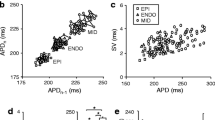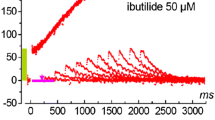Summary
Block of the delayed K+ current, iK, and the concomitant increase in refractoriness is considered an alternative to a decrease of conduction in the treatment of reentry arrhythmias. Ideally an agent should selectively prolong the action potential at high frequencies. A minimum requirement is use-dependent block. A number of drugs were tested for the existence of use dependence by applying a train of depolarizing clamps to single cardiac myocytes of the rabbit ventricle. Development of block during a long depolarizing clamp and recovery from block were also measured. Five of the nine drugs tested, i.e., disopyramide, encainide, quinidine, sotalol, and tedisamil, did not show use dependence. When a train of depolarizing clamps was applied, block was already present for the first depolarization and did not increase with repetition of the pulse. This result suggests block of the channel in the rested state or a very fast block of the open channel. Almokalant and amiodarone, and to a lesser extent dofetilide and E4031, showed use-dependent block, i.e., block increased during the train of depolarizing clamps. The time constant for the open channel block was 1.07 seconds for almokalant and 0.67 seconds for amiodarone. Recovery from block for almokalant and amiodarone was very slow: time constants measured at −50 mV were 13.9 and 12.7 seconds, respectively. For dofetilide it was in the order of minutes. The existence of this slow recovery explains why frequency-dependent changes in block were negligible or absent for frequencies above 0.5 Hz. Future research should be aimed to select drugs with a slower onset of active state block and faster recovery from block.
Similar content being viewed by others
References
The Cardiac Arrhythmias Suppression Trial (CAST) Investigators. Preliminary report: Effect of encainide and flecainide on mortality in a randomized trial of arrhythmia suppression after myocardiac infarction.N Engl J Med 1989;321:406–412.
Hondeghem LM, Snyders DJ. Class III antiarrhythmic agents have a lot of potential but a long way to go. Reduced effectiveness and dangers of reverse use-dependence.Circulation 1990;81:687–690.
Surawicz B. Electrophysiologic substrate of torsades de pointes: Dispersion of repolarization or early afterdepolarizations?J Am Coll Cardiol 1989;14:172–184.
Carlsson L, Almgren O, Duker G. QTU prolongation and torsades de pointes induced by putative Class III antiarrhythmic agents in the rabbit: Etiology and interventions.J Cardiovasc Pharm 1990;16:276–285.
Carmeliet E. Use-dependent block of the delayed K+ current in cardiac cells. A comparison of different drugs with Class III activity.J Mol Cell Cardiol 1992;24(Suppl I):S108.
Tytgat J, Vereecke, J, Carmeliet E. A combined study of sodium current and T-type calcium current in isolated cardiac cells.Pflügers Arch 1990;417:142–148.
Carmeliet E. Block of the delayed K+ current by Hässle 234/09 in rabbit cardiac myocytes.J Mol Cell Cardiol 1991;23(Suppl V):P69.
Carmeliet E. Voltage- and time-dependent block of the delayed K+ current in cardiac myocytes by dofetilide.J Pharm Exp Ther 1992;262:809–817.
Sanguinetti MC, Jurkiewicz NK. Two components of cardiac delayed rectifier K+ current: Differential sensitivity to block by Class III antiarrhythmic agents.J Gen Physiol 1990;96:195–215.
Colatsky TJ, Follmer CH, Starmer CF. Channel specificity in antiarrhythmic drug action. Mechanism of potassium channel block and its role in suppressing and aggravating cardiac arrhythmias.Circulation 1990;82:2235–2242.
Roden DM, Bennett PB, Snyders DJ, et al. Quinidine delays IK activation in guinea-pig ventricular myocytes.Circ Res 1988;62:1055–1058.
Balser JR, Bennett PB, Hondeghem LM, Roden DM. Suppression of time-dependent outward current in guinea-pig ventricular myocytes. Action of quinidine and amiodarone.Circ Res 1991;69:519–529.
Furukawa T, Tsujimura Y, Kitamura K, et al. Time- and voltage-dependent block of the delayed K+ current by quinidine in rabbit sinoatrial and atrioventricular nodes.J Pharm Exp Ther 1989;251:756–763.
Snyders DJ, Knoth KM, Roberds SL, Tamkun MM. Time-, and voltage-, and state-dependent block by quinidine of a cloned human cardiac potassium channel.Mol Pharmacol 1992;41:322–330.
Author information
Authors and Affiliations
Rights and permissions
About this article
Cite this article
Carmeliet, E. Use-dependent block of the delayed K+ current in rabbit ventricular myocytes. Cardiovasc Drug Ther 7 (Suppl 3), 599–604 (1993). https://doi.org/10.1007/BF00877626
Received:
Accepted:
Issue Date:
DOI: https://doi.org/10.1007/BF00877626




